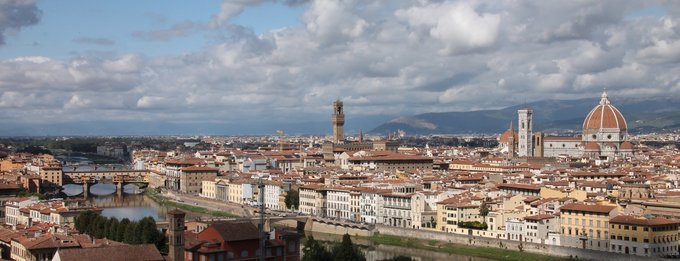Die Inhalte dieser Seite sind leider nicht auf Deutsch verfügbar.
Seitenpfad:
- INTERCOAST
- Latest News
- Archiv
- News 2015
- SCACR 2015 in Florence
SCACR 2015 in Florence
The SCACR is a biannual event for scientists, field and laboratory experimentalists, theoretical and numerical modelers in the field of coastal engineering. After events in Spain, Germany and Portugal in the previous years, the conference returned to its country of origin for this year’s edition. SCACR 2015 was hosted by the University of Florence in the heart of the city which is a UNESCO World Heritage site, and was attended by 130 participants from 21 countries.

The Aula Magna Rettorato of the University of Florence
The technical sessions (held in the Aula Magna Rettorato, the Rectorate’s auditorium of the University) covered 42 oral presentations and 26 posters and were preceded by keynote lectures given by Dr. Marcel van Gent (Deltares, The Netherlands), Prof. António Falcão (Instituto Superior Tecnico, Portugal), Giovanni Cecconi (Consorzio Venezia Nuova, Italy), Prof. Nobuhisa Kobayashi (University of Delaware, USA) and Prof. Javier López Lara (IH Cantabria, Spain). SCACR originates from a coastal engineering background and the presentations given during this year’s event ranged from coastal morphodynamics, fluid-structure interaction and coastal development to sustainable coastal protection, marine energy resources and the impacts of climate change, presenting field experiments,
laboratory setups and numerical models. I had the opportunity to present my work on a numerical model of the flow through a sediment bed in an oral presentation, moving the discussion from large-scale sediment transport to micro-scale processes. The presentation ensued some comments and questions and productive feedback was still given during the next days.
The side program included a guided visit to the Museo Galileo in Florence, which hosts an impressive collection of scientific instrumentation (including Galileo’s telescopes) in an 11th century building. After the conference, the technical tour offered a visit to the MOSE project in Venice. MOSE (MOdulo Sperimentale Elettromeccanico) is a flood protection system consisting of 78 mobile flap gates that will be installed in four barriers at the inlets of the Venetian Lagoon. In combination with other measures like beach reconstructions, new breakwaters and raised quaysides, MOSE will protect the city of Venice and the lagoon’s environment from flooding during high water levels. Every flap gate resembles a metal tank that is connected to a concrete housing with two 42-ton hinges. When not in use, the gates are filled with water and rest on the seabed. If a high tide is forecasted, air is injected into the gates, thus expulsing the water, and the gates rise to the water surface rotating around the hinges.
The side program included a guided visit to the Museo Galileo in Florence, which hosts an impressive collection of scientific instrumentation (including Galileo’s telescopes) in an 11th century building. After the conference, the technical tour offered a visit to the MOSE project in Venice. MOSE (MOdulo Sperimentale Elettromeccanico) is a flood protection system consisting of 78 mobile flap gates that will be installed in four barriers at the inlets of the Venetian Lagoon. In combination with other measures like beach reconstructions, new breakwaters and raised quaysides, MOSE will protect the city of Venice and the lagoon’s environment from flooding during high water levels. Every flap gate resembles a metal tank that is connected to a concrete housing with two 42-ton hinges. When not in use, the gates are filled with water and rest on the seabed. If a high tide is forecasted, air is injected into the gates, thus expulsing the water, and the gates rise to the water surface rotating around the hinges.
Our tour started at the Venice Arsenal and the MOSE control room where Giovanni Cecconi of the Consorzio Venezia Nuova introduced us to the MOSE system and management and showed us one of the mobile gates. Afterwards we boarded a ship that took us to Lido inlet to look at the completed coastal structures above the water level: an artificial island in the middle of the inlet, separating the two flood barriers Lido North and Lido South, and the lock that allows passage of small crafts when the flood barriers are closed. While the installation of the gates is completed at Lido North and has been successfully tested, construction of the other three barriers is still ongoing.

Participants of the technical tour in front of one of the MOSE gates at the Venice Arsenal
The SCACR 2015 conference was a great opportunity to meet international scientists and engineers and to present and discuss my research work. In addition to many interesting presentations, the keynote lectures and the technical tour presented opportunities and future challenges for coastal and marine scientists and engineers. Florence and the University’s Aula Magna offered a stunning atmosphere for a conference talk (including frescos and tapestry). Many thanks to INTERCOAST and the DFG for funding my participation.
Further information:
http://www.scacr.eu/
http://scacr2015.dicea.unifi.it/index.html
https://www.mosevenezia.eu/?lang=en
Further information:
http://www.scacr.eu/
http://scacr2015.dicea.unifi.it/index.html
https://www.mosevenezia.eu/?lang=en



